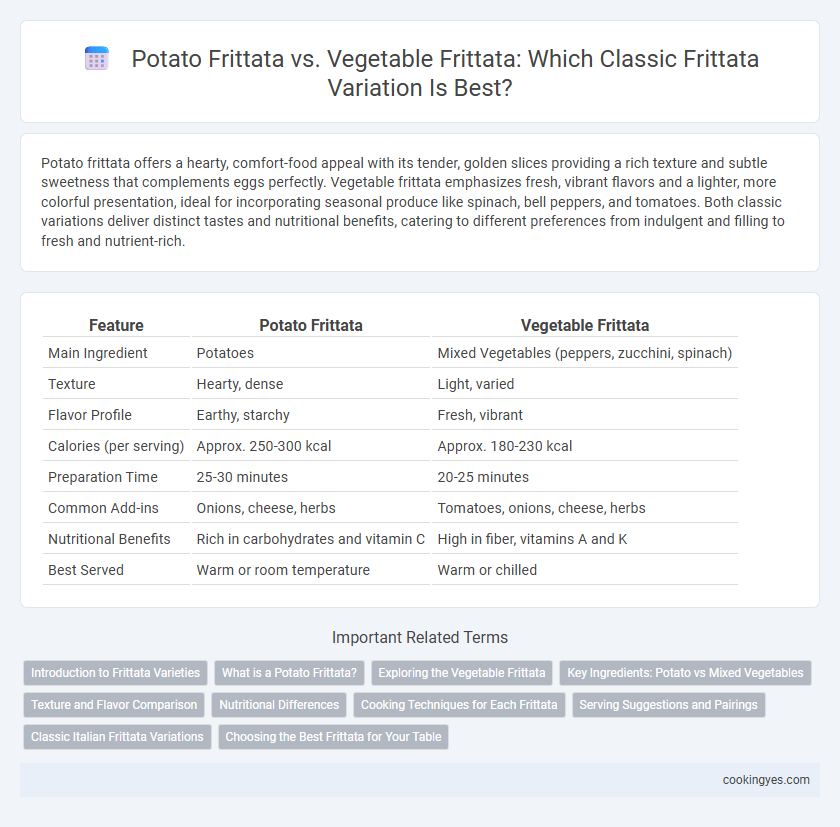Potato frittata offers a hearty, comfort-food appeal with its tender, golden slices providing a rich texture and subtle sweetness that complements eggs perfectly. Vegetable frittata emphasizes fresh, vibrant flavors and a lighter, more colorful presentation, ideal for incorporating seasonal produce like spinach, bell peppers, and tomatoes. Both classic variations deliver distinct tastes and nutritional benefits, catering to different preferences from indulgent and filling to fresh and nutrient-rich.
Table of Comparison
| Feature | Potato Frittata | Vegetable Frittata |
|---|---|---|
| Main Ingredient | Potatoes | Mixed Vegetables (peppers, zucchini, spinach) |
| Texture | Hearty, dense | Light, varied |
| Flavor Profile | Earthy, starchy | Fresh, vibrant |
| Calories (per serving) | Approx. 250-300 kcal | Approx. 180-230 kcal |
| Preparation Time | 25-30 minutes | 20-25 minutes |
| Common Add-ins | Onions, cheese, herbs | Tomatoes, onions, cheese, herbs |
| Nutritional Benefits | Rich in carbohydrates and vitamin C | High in fiber, vitamins A and K |
| Best Served | Warm or room temperature | Warm or chilled |
Introduction to Frittata Varieties
Potato frittata features tender, crispy potatoes that add a hearty texture and rich flavor, making it a satisfying classic variation. Vegetable frittata emphasizes a colorful mix of seasonal vegetables like spinach, bell peppers, and zucchini, offering a fresh, nutrient-dense option. Both variations maintain the traditional Italian egg base, showcasing versatility in texture and taste for diverse culinary preferences.
What is a Potato Frittata?
A Potato Frittata is a classic Italian dish featuring sauteed or roasted potatoes combined with eggs, often seasoned with onions, herbs, and cheese for a hearty texture and rich flavor. This variation distinguishes itself from a Vegetable Frittata by emphasizing the creamy, starchy potatoes that provide a satisfying base, compared to the diverse medley of fresh vegetables in the latter. The Potato Frittata's simplicity and robust taste make it a popular choice for traditional breakfast or brunch menus.
Exploring the Vegetable Frittata
Vegetable frittatas offer a vibrant twist on the classic potato frittata by incorporating diverse seasonal vegetables like zucchini, bell peppers, and spinach, enhancing both flavor and nutrition. This variation provides a lighter, fiber-rich alternative with vitamins A and C, compared to the denser, carbohydrate-heavy potato base. Chefs often prefer vegetable frittatas for their versatility and colorful presentation, making them ideal for breakfast, brunch, or a healthy meal option.
Key Ingredients: Potato vs Mixed Vegetables
Potato frittata highlights the creamy texture and subtle sweetness of starchy potatoes, providing a hearty and filling base, while vegetable frittata emphasizes vibrant mixed vegetables like bell peppers, zucchini, and spinach for a lighter, nutrient-rich profile. The key ingredient distinction lies in potatoes delivering a dense, comforting mouthfeel, whereas mixed vegetables contribute diverse flavors and a broader spectrum of vitamins. Both variations utilize eggs and cheese as binding agents, but the choice between potato and vegetables defines the frittata's texture and overall nutritional impact.
Texture and Flavor Comparison
Potato frittata features a dense, creamy texture with a rich, earthy flavor from the tender cooked potatoes that absorb eggs and seasonings well. Vegetable frittata offers a lighter, more varied texture due to the mix of sauteed or roasted vegetables like bell peppers, zucchini, and spinach, providing a fresh, vibrant taste profile. The choice between potato and vegetable frittata ultimately depends on whether a heartier, comfort-style dish or a colorful, nutrient-rich option is desired.
Nutritional Differences
Potato frittata offers a higher carbohydrate content and greater caloric density due to the starch-rich potatoes, providing sustained energy and increased satiety. Vegetable frittata tends to be lower in calories and carbohydrates while delivering more fiber, vitamins A and C, and antioxidants from diverse vegetables. Both variations provide quality protein from eggs, but the vegetable option supports lighter, nutrient-dense meals ideal for weight management and enhanced micronutrient intake.
Cooking Techniques for Each Frittata
Potato frittatas require slow sauteing of thinly sliced or diced potatoes to achieve a tender texture and even cooking before adding eggs, ensuring a hearty and cohesive base. Vegetable frittatas benefit from quick sauteing of mixed vegetables like bell peppers, spinach, or zucchini to maintain their vibrant colors and slight crispness while blending flavors. Both variations finish under a broiler or in the oven to set the eggs and develop a golden, slightly crispy top, optimizing texture and flavor.
Serving Suggestions and Pairings
Potato frittata pairs excellently with a crisp green salad or roasted tomatoes, enhancing its hearty texture and mild flavor. Vegetable frittata complements light and fresh sides like avocado slices or citrus-dressed arugula, balancing its vibrant and nutrient-rich profile. Both variations serve well with crusty artisan bread and a glass of white wine or sparkling water for a complete classic meal.
Classic Italian Frittata Variations
Classic Italian frittata variations highlight the versatility of ingredients like potatoes and vegetables to create distinct textures and flavors. Potato frittatas offer a hearty, creamy bite with tender, starchy layers that absorb eggs and subtle seasonings, embodying traditional northern Italian comfort food. Vegetable frittatas emphasize freshness and color, incorporating seasonal produce such as zucchini, bell peppers, and spinach, reflecting southern Italian preferences for lighter, nutrient-rich dishes.
Choosing the Best Frittata for Your Table
Potato frittata offers a hearty texture and rich flavor, making it ideal for those seeking a more filling dish with a classic Italian touch. Vegetable frittata provides a lighter, nutrient-dense option, perfect for incorporating seasonal produce and adding vibrant colors to your table. Selecting between potato and vegetable frittata depends on your preference for richness versus freshness, balancing tradition with nutritional variety.
Potato Frittata vs Vegetable Frittata for Classic Variation Infographic

 cookingyes.com
cookingyes.com